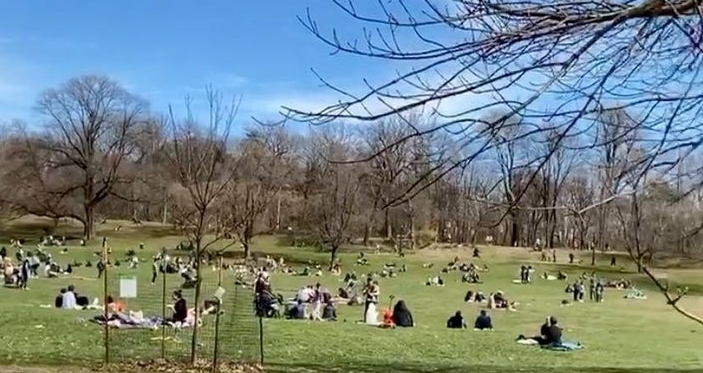55 percent of U.S. coronavirus cases are now in the state of New York, with an outbreak occurring in New York City, the most densely populated area and the largest city in the nation with more than 8 million.
More than 21,000 cases are now reported in New York City, and more than 37,000 statewide. That’s out of 68,000 nationwide.
That makes Long Island, Connecticut, New Jersey and Pennsylvania all ground zero for the rest of the country as resources shift to the northeast to mitigate and slow down the virus.
Outbreaks on the west coast in California and Washington appear to have been muted by local efforts at social distancing.
New York City has become the hotbed. Democratic Governor Andrew Cuomo issued a stay at home order on March 20 for non-essential workers. Schools in the city have been closed since mid-March.
But not everyone is listening, and now New York has the most cases. 58 percent of their cases in Queens and Brooklyn, where anecdotally, relatives of mine who live in the city report people walking around, hanging out and socializing as if they were on vacation with colleges also closed.
Similarly, the New York Times on March 21 reported certain areas where city life was still functioning as if it were normal: “Elsewhere, outdoor life seemed to thrive in ways that, given the constant reminders for social distancing, seemed reckless. The crowds at the farmers market in Union Square were the size of a pre-coronavirus weekend, with shoppers at one another’s elbows. Some neighborhoods in Queens and the Bronx showed similar robust outings. And like Central Park, Brooklyn’s Prospect Park remained an outdoor respite for people with nowhere else to go for fresh air.”
NBC News in New York noted Democratic Governor Andrew Cuomo who on March 22 blasted his city, “saying the number of people he saw flaunting the new mandates was ‘wholly inappropriate.’ People were crowding in parks, acting as if nothing had changed.”
So, while the rest of the country has been sheltering in place and shut down for days and weeks, at least early on in the state lockdown, many people in New York City are still openly ignoring governmental health recommendations. Is that why they’re having problems now?
Perhaps the reason is because the city’s subways have been running through the entire emergency. The bridges are still open. And millions are still commuting every day to the city to and from the surrounding region. But should they still be doing so?
Here, New York City and New York State find themselves at a crossroads, and what they do next will have reverberations throughout the entire country. If Governor Cuomo wanted to, he could order the streets to be cleared with the National Guard to assist police in order to somehow enforce social distancing but so far has ruled out any aggressive approach to the issue. Is he right?
Now, perhaps how the country responds to New York will tell us how seriously we’re still taking the coronavirus. So far, the federal government has recommended that persons who have been to New York recently stay apart from others for 14 days. Are they listening?
But the rest of the country could force the issue as those outside New York also have to consider the risks. Maybe a message could be sent.
Should planes still be flying in and out of New York?
Should Amtrak still be running the Northeast Regional up and down the east coast? The Acela nonstop to Washington, D.C. has been suspended since March 7.
What about regional trains that go in and out of New York every day? Buses?
On the other hand, then there’s the data. Dr. Deborah Birx, the White House coronavirus task force coordinator, suggested yesterday the infection rate of the Chinese coronavirus could be much lower than had originally been projected in certain models.
“Either we’re only measuring the tip of the iceberg… or we have the transmission completely wrong… The predictions of the models don’t match the reality on the ground,” Birx said.
She added, “When people start talking about 20 percent of a population being infected, it’s very scary… But we don’t have data that matches that based on the [actual] experience.”
Meaning, even if the fatality rate for the virus is elevated above seasonal flu, the likelihood of it spreading to the entire population might be much lower than originally feared. Is she right?
Let’s hope so, but that needs to be sorted out as soon as possible. The entire country is shut down, costing tens of trillions of dollars to the global economy that will have reverberations for at least a decade. Unemployment could quickly go to double digits and might stay there for months or years. Many businesses being closed now will never return.
Is there a great risk for widespread infection or not? Because now that the virus is all over New York, this would be the time to stop it if this disease is as bad as they say before it keeps spreading.
Perhaps the prevalence of the virus in New York might mean additional measures should be considered at containment there even while the rest of the country gets prepared to reopen. Many New Yorkers are not heeding the stay at home order. The worse it gets, the more likely further regional spread will become up and down the eastern seaboard, and the longer this goes on for everyone else.
Robert Romano is the Vice President of Public Policy at Americans for Limited Government.







